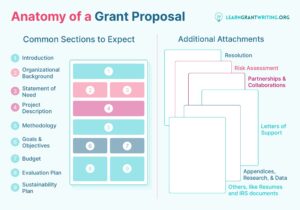
Major Gifts…Your 2025 Mandate!
December 29, 2024
Crappy Funding Practices Proves, Once Again, Vu Lee Is Bad for Charity
January 4, 2025Picking Your Priorities: 4 Key Tests Before Grant Writing

Picking Your Priorities: 4 Key Tests Before Grant Writing
The stage is set: your nonprofit has a strong mission statement, stable programs, and enough team capacity to devote time to grant seeking.
Your team feels excited to start applying for your first grants, but wait. While all funding is helpful, is every grant truly worth the time to apply for it?
From researching funders to writing grant proposals to assembling all the required documents, applying for a grant is an investment of your time. When you compare grant opportunities carefully, you’ll find that some of these investments offer better benefits than others!
Before getting too deep into the application process, you must ensure you choose the best opportunity for your nonprofit.
Prioritization is an invaluable skill for grant writers, and there are tried-and-true tests you can use to feel confident in your choices. As you research grants, ask yourself these four critical questions to uncover the true ROI of each opportunity.

1. Does the funder give to organizations like ours?
Just because a foundation offers funding doesn’t necessarily mean they’re ready to offer it to your nonprofit. Every grantmaking organization has its own goals and preferences, and it’s up to nonprofits to confirm whether they check enough of the funder’s boxes before applying.
Test whether a funder is likely to consider a nonprofit like yours by:
- Checking the funder’s philanthropic statement. Most grantmakers clearly spell out what they’re looking for from potential awardees in their philanthropic mission statements. They commonly focus on specific mission areas, geographic locations, or beneficiary demographics.
- Researching past grant recipients. The best way to predict what a grantmaker will do in the future is by digging into their past. While many foundations require you to rummage through their Form 990s to find previous awardees, others will publish winning proposals on their website. Whether you find a trove or just a few morsels of information, use this data to see if your nonprofit matches the same profile as past recipients.
- Coordinating an introduction. If you’ve finished the first two steps but still aren’t quite sure if your nonprofit is a good fit, try to meet with the foundation. Learn Grant Writing provides some advice about how to approach these exploratory meetings:
“In this meeting, your goal is not to sell your organization or proposed project. Instead, be curious. Learn. Objectively evaluate if your organizations are a good fit for each other. If you bring this mindset shift to your meeting, you will have a much more honest, meaningful, and productive conversation. After all, nothing is worse than spending a ton of time on a grant you have no chance of winning. Be skeptical until you have enough positive data points to confirm the grant is worth your time and resources to pursue.”
Start your grant research off on the right note by conducting primary research. Search grant databases for keywords related to your nonprofit. For instance, an environmental nonprofit dedicated to keeping the Mississippi River clean might filter grant opportunities to Mississippi and search key terms like “clean water,” “pollution reduction,” and “sustainability.”
This approach helps you find grantmakers who are likely interested in you and increases your chances of winning from the minute you sit down to write the proposal.
2. Is the grant too competitive?
A common mistake grant writers make is aiming too high too soon. While it’s good to have high aspirations, stay realistic. For most nonprofits, this means avoiding competing with thousands of other organizations for just a few winning spots.
In the grant writing world, a handy rule of thumb is that nonprofits should only apply for grants they have at least a 20% chance of winning.
The team at Learn Grant Writing also teaches a method for approximating a funder’s competitiveness. Compare the number of previous applicants to a funder’s funding cycle to the number of grants awarded to calculate their rough win rate. (This information may sometimes be available online, but contacting the funder with your questions is often easier.)
Put another way, this rule of thumb also means you don’t necessarily need to rule out grants with many applicants if there are also many winners.
For example, the National Endowment for the Arts is one of the biggest federal funders for artistic organizations, and one of their grant programs received almost 2,000 applicants in 2023. That’s a lot of competition!
However, almost 1,000 of those applicants also won funding. That gives the program an incredible win rate of around 50%, but is this the whole picture?
Just like with our first grant prioritization test, research is your friend here. Digging a bit deeper into the NEA, we see that of the almost 1,000 winners, less than 100 were first-time applicants. These organizations can certainly still win funding (and often do!), but they’re clearly up against experienced competitors who already know what the NEA wants.
In situations like these, the question of competition becomes a bit complicated. Is the grant just generally too competitive based on the numbers, or is it too competitive for a nonprofit like yours? In the latter case, adjust your approach. Rather than jumping straight into the deep end with a massive federal grantmaker like the NEA, try out shallower, less competitive waters until you’ve built up your grant writing skills.
3. Do we have a relationship with the funder?
Only 28% of U.S.-based foundations accept unsolicited proposals (i.e. from nonprofits they’ve never met before or haven’t explicitly invited to apply). For nonprofits looking for new grant opportunities, these numbers hurt.
One bright spot: About half of all the top funders with over $100 million in assets do accept unsolicited proposals. But that still leaves a ton of grants your nonprofit can’t apply for!
Before judging these grantmakers too harshly, consider their perspectives.
The Ford Foundation is a massive grantmaker that accepts unsolicited grant proposals. Over one year, they received over 144,000 grant-related inquiries and proposals for less than 3,000 winning spots.
Think of the work that goes into reviewing all those applications! Very few grantmakers have the capacity to handle that, so most keep the door closed.
And for those who do apply, these numbers mean only a 2% chance to win a Ford Foundation grant, way below our 20% threshold.
At its heart, grants are another type of fundraising, and all fundraising is built on relationships. If you have a strong relationship with a grantmaker, they’re more likely to consider your application or invite you to apply. To build these relationships, try:
- Attending conferences. Grant writing and nonprofit conferences are not just a chance to meet fellow grant writers but also to connect with funders. Some foundations even host workshops specifically about their grant opportunities.
- Asking board members to search their networks. Your nonprofit’s board has many responsibilities, and one of them is to do the networking for you. Ask well-connected board members to search through their many friends and see if any have connections to grantmaking foundations.
- Maintaining correspondence with past grantors. If you’ve received a grant, great! But instead of taking the money and only providing mandatory reports, go the extra mile with your reporting and continue to stay in touch. Not only will keeping this connection strong increase your odds of winning funding again from them in the future, but some grantmakers are buddies with other grantmakers—and they might be willing to give you an in with their friends.
If you have a strong relationship with a grantmaker, and they’re willing to accept a proposal, it’s almost always worth it to apply. You’ll have higher chances of winning, but even if you don’t, you’ll keep that relationship strong for the next time around.
4. Is the grant worth the cost of applying?
Whether you have an in-house or freelance grant writer, grant writing is an expense just like any other use of your time and resources. Between research, writing a proposal, and assembling necessary materials, many hours go into submitting a grant application, and you won’t know if you’ve generated value from those hours until you hear back from the funder.
With this in mind, some grants may simply not be worth the time needed to apply for them. While a $1,000 grant is nice, it’s a little less nice when you realize you spent $2,000 worth of team time earning it.
Along with looking for high-value grants, make your nonprofit an efficient grant-writing machine by:
- Researching opportunities regularly. An ineffective approach is to dig through grant databases, find about 8-10 grants, and apply for those until the opportunities dry up. Instead, make finding new grants a part of your regular grant workflow. There are many popular grant database options that span all budget ranges.
- Creating templates. While every grant proposal should be tailored to the grantmaker, details about your organization likely won’t change between grant applications. Create templates of common grant sections that can be quickly added to your proposal and refined rather than rewritten from scratch every time.
- Having documents ready. Most grantmakers ask to see the same supplemental documents from applicants, so ensure collecting them is easy. Get the ball rolling early by doing your research and securing needed documents so you don’t get stuck waiting on your board to sign off on something right before a deadline.
Grants are an investment, and the return on that investment depends on several factors, including your nonprofit’s priorities, grant writing experience level, capacity to apply, and more.
Don’t fall into the trap of going for big, shiny grants that just end up wasting your time and money! This can lead to a negative spiral of lost grants and your board eventually deciding forgo them as a revenue source altogether.
Instead, know your nonprofit’s strengths and apply these tests to identify grants you have a decent shot at winning. This way, you can focus on numerous grants that are worth the effort.
Grants seem like free money, but are they actually? Yes and no. They require careful thought, preparation, time, and resources. Master the art of grant prioritization, and you’ll set your organization up for more funding won more efficiently.
The post Picking Your Priorities: 4 Key Tests Before Grant Writing appeared first on Nonprofit Hub.
